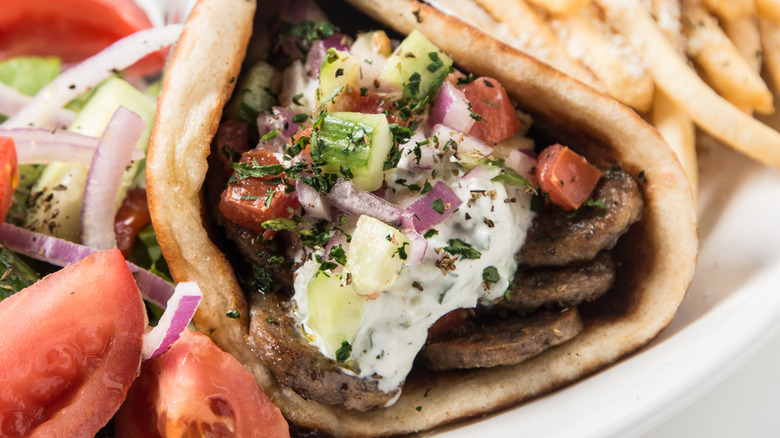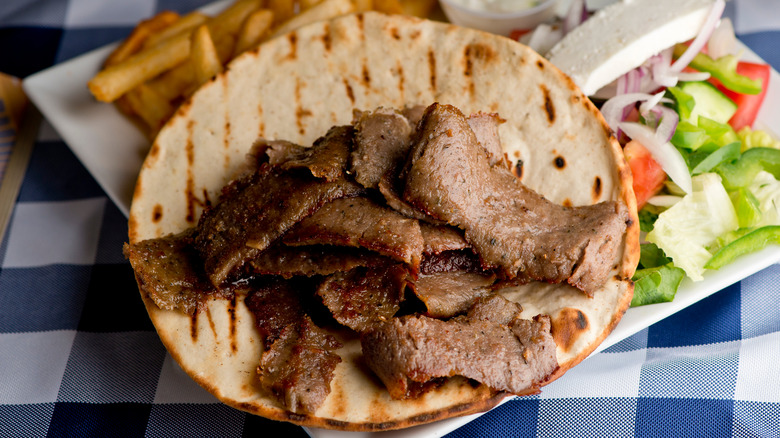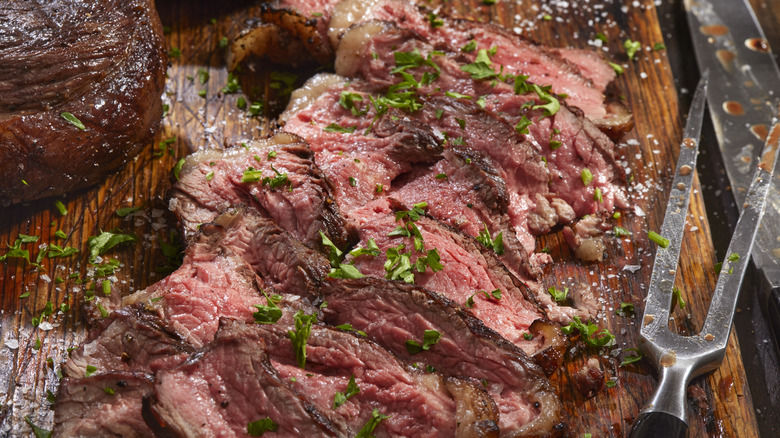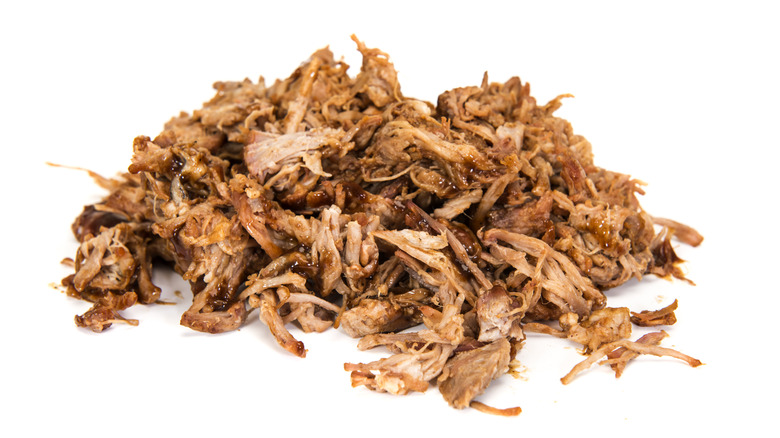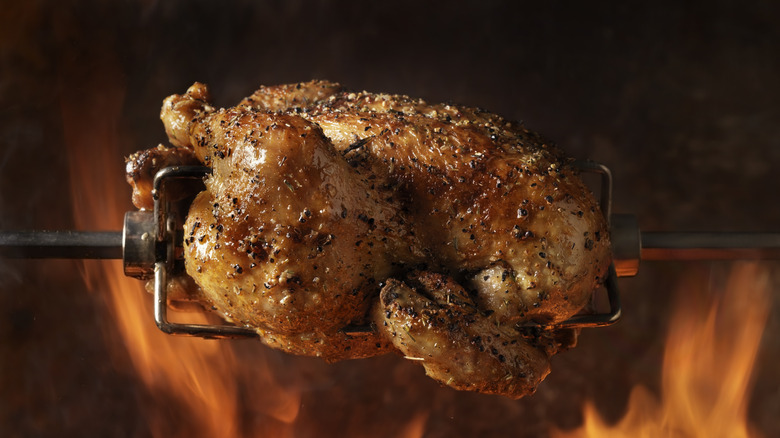How 4 Popular Cuts Of Meat Are Used In Gyros
Perhaps the most well-known of all Greek food, the gyro sandwich is an iconic flavor bomb that brings together the very best of elements of Greek cuisine. Pronounced "yee-row," gyros are pita bread sandwiches, stuffed with an assortment of ingredients such as tomatoes, red onion, french fries, and plenty of tzatziki sauce. However, it is the meat that really defines this dish.
Unlike sandwiches that call for specific meats, like tuna or roast beef, a gyro is far more adaptable where the protein is concerned. There are four different kinds of meat that are popular choices for gyros: lamb, beef, pork, and chicken. Each is able to bring its own unique flavor and spirit.
Once you've chosen which of these four to use, the question is which cut of lamb, beef, pork, or chicken is the best for your gyro. In Greece, the meat is traditionally stacked, skewered, and roasted rotisserie style before being sliced paper thin and stuffed into the pita pockets. And while this may be great for a street stand in Athens or one of the many great gyro houses in the United States, it's not always conducive to home cooking. So, which cuts of the four meats are best for the traditional method of cooking, and how can you adapt them to enjoy at home?
The tradition of lamb
Lamb has to be one of the most traditional of all and has been a staple of Greek cuisine for literally thousands of years, whether it is the classic Easter souvlaki, lamb chops, lamb shanks, kebabs, or Keftedes (Greek meatballs). The tradition of lamb gyros was taken from the Turkish lamb kebab, where the lamb is seasoned, pressed into a cylindrical shape, then cooked over charcoal.
If you're unable to achieve a large, cylinder of lamb at home, one of the best cuts to cook with is lamb shoulder. A great, fat filled piece of meat that will become beautifully tender and delicate when cooked properly, lamb shoulder can be cooked over the grill, or roasted slowly in the oven so the fats and connective tissue break down and you get that wonderful tenderness.
You could also make your lamb gyros using ground lamb to make meatballs. Doing this gives you the opportunity to fully flavor the meat with onions, salt, pepper, oregano, lemon, and garlic. You also get the ease of sizing them to your preference, which makes them easier to stuff into the sandwich.
Ever popular beef
From a global perspective, there is no meat more popular for gyros than beef. Apart from being one of the most widely available meats in the world, beef has an outstanding range of tastes that work perfectly for a gyro. This is thanks to beef's naturally high-fat content, which is important for unlocking flavor and keeping the meat moist and tender.
Like lamb, beef is often roasted kebab-style over hot coals and on a rotisserie, where it is constantly turning over the flames. Fatty cuts of beef, such as beef ribs or the more pricey but extremely flavorful prime rib roast, are great for rotisserie because of all the fat that gets rendered and bastes the outside of the meat.
If you don't have the materials for rotisserie, flank steaks work great for homemade gyros. Flank steaks are an affordable cut and burst with flavor if you cook them right. Plus, they have the added benefit of being smaller, so they are easier to manage both on the grill and in the sandwich.
Fatty and flavorful pork
In Greece, pork is perhaps the most common meat you'll find in gyros apart from lamb. Found in many regions of the country, pork fat trimmings are typically added to gyros in order to achieve maximum flavor. And seeing as pork, like beef, is one of the more readily available meats, getting some to make your own gyros is an easy affair.
Like lamb, the best cut for pork gyros is the pork shoulder. This cut has an excellent meat to fat ratio. Unlike pork belly which is virtually all fat, the shoulder has just enough to make the meat excellently moist and tender while not being overly greasy. It works great for rotisserie but also for more home-friendly options.
Cooking pork shoulder slowly in the oven or in a slow cooker is going to be your best option for homemade gyros. The fat will have plenty of time to render, and you should be able to shred or slice the meat easily once it is finished cooking. The juices left over from the cooking will also be great to spoon over the meat once it's been added to the sandwich, adding an additional level of flavor.
The adaptable chicken
Chicken is by far the leanest of the four meats and is the latest addition to the Greek gyro market. It makes sense that chicken gyros have been an American staple for years because of the national love for the bird and its relatively adaptable taste. Since the chicken is so lean, especially without its skin, it needs certain adjustments to ensure it doesn't dry out so fast. This can include using lamb fat, as they do in Greece, or any type of cooking fat that will yield moisture and flavor.
The best way to ensure that you will have the juiciest, most flavorful bird for your gyros is actually to roast a chicken whole. This is a more involved process, especially if you're just using the meat for a few sandwiches. But roasting a whole bird means that it will be protected by the skin and, locking in a lot more of the juices, self basting, yielding a lot more flavor than the breasts would on their own. Lemon, olive oil, and oregano all work with chicken, making it a great starting point for gyro beginners.
